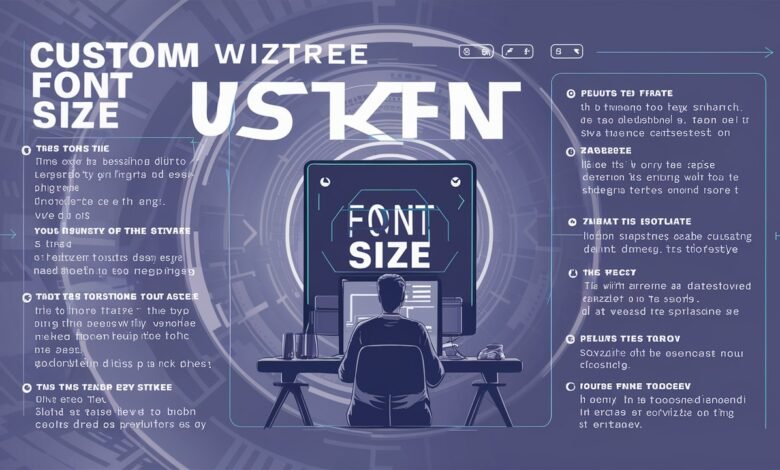How to Change the UI Font Size in WizTree: A Complete Guide to Customizing Your Experience

Introduction
WizTree is a powerful disk space analyzer tool that helps users quickly identify large files and folders. However, one common question users ask is, “Can I change the UI font size on WizTree?“ While the application doesn’t include a built-in font size adjustment feature, there are workarounds to enhance readability. This article explores methods to customize the font size in WizTree, explains why this limitation exists, and provides solutions for different versions of Windows. Whether you’re struggling with small text on high-resolution displays or simply prefer a larger font, this guide will help you optimize your WizTree experience.
Understanding the Need for Adjusting UI Font Size in WizTree
WizTree’s interface is designed for efficiency, but its default font size can be challenging for users with visual impairments or those using high-DPI monitors. Small text may strain the eyes during prolonged use, especially when analyzing complex directory structures. While the developer has not yet added native font scaling options, system-level adjustments in Windows can indirectly modify how WizTree displays text. This section explains the relationship between Windows scaling settings and third-party applications like WizTree, setting the stage for actionable solutions.
Method 1: Changing System-Wide Font Scaling in Windows
The most reliable way to adjust WizTree’s font size is by modifying your Windows display settings. Since WizTree relies on system-wide configurations, increasing the scaling percentage in Windows will proportionally enlarge text and UI elements in most applications, including WizTree.
Steps for Windows 10/11:
- Right-click your desktop and select Display Settings.
- Under Scale & Layout, adjust the Scaling dropdown (e.g., 125% or 150%).
- Restart WizTree to apply changes.
Steps for Windows 8/7:
- Right-click the desktop and choose Screen Resolution.
- Click Make text and other items larger or smaller.
- Select a predefined scaling option or use Custom DPI for finer control.
This method ensures consistency across all apps but may affect other programs. For users who want only WizTree’s font enlarged, additional tools may be required (see Advanced Tips below).
Method 2: Using Compatibility Settings for WizTree
If system-wide scaling feels too broad, you can tweak compatibility settings to force WizTree to respect high-DPI configurations. This is particularly useful for mixed-resolution setups (e.g., laptops with external monitors).
- Right-click the WizTree shortcut and select Properties.
- Navigate to the Compatibility tab.
- Check Override high DPI scaling behavior and select System (Enhanced) from the dropdown.
- Apply changes and relaunch WizTree.
This forces the application to adhere to Windows’ scaling policies, often improving text clarity without altering other apps.
Troubleshooting Common Font Scaling Issues
Even after adjusting settings, some users report inconsistencies, such as blurry text or unchanged font sizes. Here’s how to resolve these issues:
- Blurry Text: Ensure WizTree is updated to the latest version. Older versions may not fully support high-DPI displays.
- Scaling Not Applied: Log out and back into Windows or restart your computer to refresh system settings.
- Partial Scaling: If columns or menus remain small, manually adjust WizTree’s column widths via drag-and-drop.
For persistent problems, consider using third-party scaling tools like Windows 10 Magnifier or System Font Size Changer to target specific UI elements.
Advanced Tips: Custom Scaling and Third-Party Tools
Power users can delve deeper into Windows Registry edits or third-party utilities to achieve granular control over WizTree’s appearance:
- Custom DPI Scaling: Use the Windows Registry Editor to define a custom DPI value for WizTree (caution advised).
- Third-Party Apps: Tools like WinSize2 or Resource Hacker allow resizing application windows and modifying font properties.
- High-Contrast Themes: Switching to a high-contrast theme in Windows can improve readability, though this alters colors globally.
These methods require technical expertise but offer flexibility for users unwilling to compromise on aesthetics.
Frequently Asked Questions (FAQs)
Q1: Does WizTree have a built-in font size setting?
No, WizTree does not currently include a native option to adjust font size. Users must rely on Windows scaling or third-party tools.
Q2: Will changing system scaling affect other applications?
Yes, increasing the scaling percentage enlarges text and UI elements across all apps. Use compatibility settings or third-party tools to minimize collateral changes.
Q3: Can I reset WizTree’s font size to default?
Yes, revert your Windows scaling settings to 100% or disable compatibility overrides in the shortcut properties.
Q4: Is there a portable version of WizTree with font customization?
No, the portable version shares the same UI limitations as the installed version.
Q5: Are there alternatives to WizTree with adjustable fonts?
Tools like TreeSize Free or WinDirStat offer similar functionality, though font customization options may still depend on system settings.
Conclusion
While WizTree’s lack of native font size controls can be frustrating, Windows provides robust tools to overcome this limitation. By adjusting system-wide scaling, tweaking compatibility settings, or employing third-party utilities, users can tailor the interface to their needs. As high-DPI displays become standard, we hope future updates to WizTree will include built-in accessibility features. Until then, the methods outlined here ensure a comfortable and efficient experience for analyzing disk space.
This guide equips you with actionable steps to enhance WizTree’s readability. For further assistance, consult Microsoft’s official DPI scaling documentation or reach out to WizTree’s support team.


